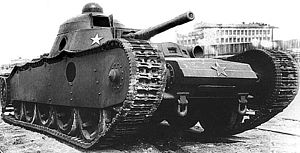Tank Grote
| Tank Grote | |
|---|---|

|
|
| General properties | |
| crew | 5 men |
| length | 6.50 m |
| width | 2.81 m |
| height | 3.04 m |
| Dimensions | 25 t |
| Armor and armament | |
| Main armament | 1 cannon 76.2 mm (PS-3/50 shells) |
| Secondary armament | 1 cannon 37 mm (GS / 80 grenades), 5 MG 7.62 mm (DT / Maxim / 7000 cartridges) |
| agility | |
| drive | Otto engine M-6 365 kW (500 PS) |
| Top speed | 35 km / h (road), 25 km / h (terrain) |
| Power / weight | |
| Range | 250 km |
The Tank Grote ( Russian ТГ, Танк Гроте ) was a Soviet tank .
After visiting a Soviet trade mission in Germany in 1929/30, the German engineer Eduard Grote was invited to the USSR to build a heavily armored medium tank as an alternative to the T-24 based on his designs and ideas . In 1930 work began on such a model under the name TG (Tank Grote).
The TG should weigh almost 20 tons, be 40 km / h fast and have 15 to 30 mm armor. A 240 hp gasoline engine specially designed by Grote was planned as the propulsion system ; the armament was to consist of a heavy and a light cannon and five machine guns . The design was given the highest priority among the test samples from 1931 and a pilot series of 50 to 75 tanks was already planned in preparation for a planned large-scale production of over 2000 units. That is why the T-24 was only seen as an interim solution and production, which had just started, was cut back.
At the end of 1930, a leading Soviet tank designer visited Great Britain and was presented with the Vickers A-6 (Mk.III) . The report he made about it caught the attention of the Soviet high command, which saw its current ideas about the motorization and mechanization of armament better fulfilled.
In the meantime, work on the TG was well advanced and the prototype was completed in the summer of 1931. He was armed with a 76.2 mm cannon in the hull front with a small horizontal and vertical swivel range , a 37 mm cannon in a turret above and five machine guns in different directions in the hull and in the sides of the drive.
Since the engine designed by Grote was not yet ready, a normal M-6 engine was installed. This drove a combined road / track drive, which was borrowed from the American Christie tank . This allowed the tank to be driven directly on the road on five large pairs of wheels with rubber treads after removing the chains, thus reducing chain wear.
The tests ran until the end of 1931, whereby the drive and the drive proved to be prone to failure. After evaluating the test results, it was therefore decided to leave the TG in the status of a test model and to use the British Vickers tank or the American Christie tank as the basis for an operational model. Even after eliminating the problems and successfully completing the tests, the TG did not go into production; Eduard Grote had to leave the USSR in 1933. Even if the TG did not go into series production in the end, it turned out to be an important milestone for the Soviet tank builders, with which they could gain valuable experience in the development of a medium tank.
Further technical data
- Ground clearance: 0.50 m
- Ground pressure : 0.50 kgf / cm²
- Gradeability: 40 °
- Ability to cross: 3.00 m
- Climbing ability: 1.00 m
- Wading ability: 1.20 m
Web links
- Tank Grote on nemo.nu (English)
- Tank Grote on battlefield.ru (Russian)